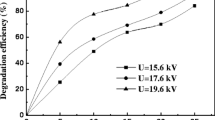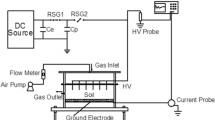Abstract
In the present work, plasma remediation of p-nitrophenol (PNP) contaminated soil was performed in a novel spray-type coaxial cylindrical dielectric barrier discharge (DBD) system at ambient temperature. This system is capable of generating large-size nonthermal plasma (NTP) and improving the diffusion and transfer of chemical active species around the dispersed soil particles. Several key parameters including plasma treatment time, discharge voltage, soil granular size, the entry speed of soil, PNP initial concentration, gas variety, and gas flow rate were investigated in terms of PNP degradation and energy efficiencies. Under the optimized experimental conditions, 54.2% of PNP was degraded after only 50 s discharge treatment, indicating that the spray-type coaxial cylindrical DBD system can degrade organic pollutants in soil more quickly compared to other plasma systems due to its efficient transfer of reactive oxygen and nitrogen species (RONS) into the contaminated soil. The possible PNP degradation pathways were proposed based on intermediates identification results and the role of reactive species analysis. The toxicological assessment of the PNP decomposition products was conducted by quantitative structure-activity relationship (QASR) analysis. This work is expected to provide a potential plasma technology for rapid and efficient processing of industrial organic pollutants contamination soil.










Similar content being viewed by others
References
Aggelopoulos CA, Svarnas P, Klapa MI, Tsakiroglou CD (2015) Dielectric barrier discharge plasma used as a means for the remediation of soils contaminated by non-aqueous phase liquids. Chem Eng J 270:428–436. https://doi.org/10.1016/j.cej.2015.02.056
Aggelopoulos CA, Tataraki D, Rassias G (2018) Degradation of atrazine in soil by dielectric barrier discharge plasma-potential singlet oxygen mediation. Chem Eng J 347:682–694. https://doi.org/10.1016/j.cej.2018.04.111
Aggelopoulos CA, Tsakiroglou CD (2021) A new perspective towards in-situ cold plasma remediation of polluted sites: direct generation of micro-discharges within contaminated medium. Chemosphere 266:128969. https://doi.org/10.1016/j.chemosphere.2020.128969
Aggelopoulos CA (2022) Recent advances of cold plasma technology for water and soil remediation: a critical review. Chem Eng J 428:131657. https://doi.org/10.1016/j.cej.2021.131657
Chen HL, Lee HM, Chen SH, Chang MB (2008) Review of packed-bed plasma reactor for ozone generation and air pollution control. Ind Eng Chem Res 47:2122–2130. https://doi.org/10.1021/ie071411s
Di Paola A, Augugliaro V, Palmisano L, Pantaleo G, Savinov E (2003) Heterogeneous photocatalytic degradation of nitrophenols. J Photoch Photobio A 155:207–214. https://doi.org/10.1016/S1010-6030(02)00390-8
Du C, Yan J (2017) Remediation of phenanthrene-contaminated soil using non-thermal plasma fluidized bed. Plasma remediation technology for environmental protection, Springer Singapore, Singapore 7-20. https://doi.org/10.1007/978-981-10-3656-9_2.
Guo H, Wang Y, Liao L, Li Z, Pan S, Puyang C, Su Y, Zhang Y, Wang T, Ren J, Li J (2022) Review on remediation of organic-contaminated soil by discharge plasma: plasma types, impact factors, plasma-assisted catalysis, and indexes for remediation. Chem Eng J 436:135239. https://doi.org/10.1016/j.cej.2022.135239
Hatzisymeon M, Tataraki D, Rassias G, Aggelopoulos CA (2021a) Novel combination of high voltage nanopulses and in-soil generated plasma micro-discharges applied for the highly efficient degradation of trifluralin. J Hazard Mater 415:125646. https://doi.org/10.1016/j.jhazmat.2021.125646
Hatzisymeon M, Tataraki D, Tsakiroglou C, Rassias G, Aggelopoulos CA (2021b) Highly energy-efficient degradation of antibiotics in soil: extensive cold plasma discharges generation in soil pores driven by high voltage nanopulses. Sci Total Environ 786:147420. https://doi.org/10.1016/j.scitotenv.2021.147420
Jiang N, Lu N, Shang K, Li J, Wu Y (2013) Innovative approach for benzene degradation using hybrid surface/packed-bed discharge plasmas. Environ Sci Technol 47:9898–9903. https://doi.org/10.1021/es401110h
Jiang N, Qiu C, Guo L, Shang K, Lu N, Li J, Zhang Y, Wu Y (2019) Plasma-catalytic destruction of xylene over Ag-Mn mixed oxides in a pulsed sliding discharge reactor. J Hazard Mater 369:611–620. https://doi.org/10.1016/j.jhazmat.2019.02.087
Jiang N, Li X, Guo H, Li J, Shang K, Lu N, Wu Y (2021a) Plasma-assisted catalysis decomposition of BPA over graphene-CdS nanocomposites in pulsed gas-liquid hybrid discharge: photocorrosion inhibition and synergistic mechanism analysis. Chem Eng J 412:128627. https://doi.org/10.1016/j.cej.2021.128627
Jiang N, Li X, Kong X, Zhao Y, Li J, Shang K, Lu N, Wu Y (2021b) The post plasma-catalytic decomposition of toluene over K-modified OMS-2 catalysts at ambient temperature: effect of K+ loading amount and reaction mechanism. J Colloid Interf Sci 598:519–529. https://doi.org/10.1016/j.jcis.2021.04.028
Kan H, Wang T, Yang Z, Wu R, Shen J, Qu G, Jia H (2020) High frequency discharge plasma induced plasticizer elimination in water: removal performance and residual toxicity. J Hazard Mater 383:121185. https://doi.org/10.1016/j.jhazmat.2019.121185
Li R, Liu Y, Cheng W, Zhang W, Xue G, Ognier S (2016) Study on remediation of phenanthrene contaminated soil by pulsed dielectric barrier discharge plasma: the role of active species. Chem Eng J 296:132–140. https://doi.org/10.1016/j.cej.2016.03.054
Li R, Liu Y, Mu R, Cheng W, Ognier S (2017) Evaluation of pulsed corona discharge plasma for the treatment of petroleum-contaminated soil. Sci Pollut R 24:1450–1458. https://doi.org/10.1007/s11356-016-7929-x
Li X, Zhang H, Luo Y, Teng Y (2014) Remediation of soil heavily polluted with polychlorinated biphenyls using a low-temperature plasma technique. Front Env Sci Eng 8:277–283. https://doi.org/10.1007/s11783-013-0562-8
Liu Y, Wang D, Sun B, Zhu X (2010) Aqueous 4-nitrophenol decomposition and hydrogen peroxide formation induced by contact glow discharge electrolysis. J Hazard Mater 181:1010–1015. https://doi.org/10.1016/j.jhazmat.2010.05.115
Lou J, Lu N, Li J, Wang T, Wu Y (2012) Remediation of chloramphenicol-contaminated soil by atmospheric pressure dielectric barrier discharge. Chem Eng J 180:99–105. https://doi.org/10.1016/j.cej.2011.11.013
Lukes P, Locke BR (2005) Degradation of substituted phenols in a hybrid gas-liquid electrical discharge reactor 44: 2921-2930. https://doi.org/10.1021/ie0491342.
Mu R, Liu Y, Li R, Xue G, Ognier S (2016) Remediation of pyrene-contaminated soil by active species generated from flat-plate dielectric barrier discharge. Chem Eng J 296:356–365. https://doi.org/10.1016/j.cej.2016.03.106
Schackmann A, Muêller R (1991) Reduction of nitroaromatic compounds by different Pseudomonas species under aerobic conditions. Appl Microbiol Biot 34:809–813. https://doi.org/10.1007/BF00169355
Shi HX, Xu XW, Xu XH, Wang DH, Wang QD (2005) Mechanistic study of ozonation of p-nitrophenol in aqueous solution. J Environ Sci-China 17:926–929
Wang CH, Zhang X, Wang TC, Lu N, Li J, Wu Y (2013) Role of energy input model on the remediation of the p-nitrophenol contaminated over-wet soil by pulsed corona discharge plasma. Journal of physics. Conference series 418: 12135. https://doi.org/10.1088/1742-6596/418/1/012135.
Wang C, Qu G, Wang T, Deng F, Liang D (2018) Removal of tetracycline antibiotics from wastewater by pulsed corona discharge plasma coupled with natural soil particles. Chem Eng J 346:159–170. https://doi.org/10.1016/j.cej.2018.03.149
Wang R, Wang T, Qu G, Zhang Y, Guo X, Jia H, Zhu L (2021) Insights into the underlying mechanisms for integrated inactivation of A. spiroides and depression of disinfection byproducts by plasma oxidation. Water Res 196:117027. https://doi.org/10.1016/j.watres.2021.117027
Wang TC, Lu N, Li J, Wu Y (2010a) Degradation of pentachlorophenol in soil by pulsed corona discharge plasma. J Hazard Mater 180:436–441. https://doi.org/10.1016/j.jhazmat.2010.04.049
Wang TC, Lu N, Li J, Wu Y (2010b) Evaluation of the potential of pentachlorophenol degradation in soil by pulsed corona discharge plasma from soil characteristics. Environ Sci Technol 44:3105–3110. https://doi.org/10.1021/es903527w
Wang TC, Lu N, Li J, Wu Y (2011) Plasma-TiO2 catalytic method for high-efficiency remediation of p-nitrophenol contaminated soil in pulsed discharge. Environ Sci Technol 45:9301–9307. https://doi.org/10.1021/es2014314
Wang TC, Qu G, Li J, Liang D, Hu S (2014) Depth dependence of p-nitrophenol removal in soil by pulsed discharge plasma. Chem Eng J 239:178–184. https://doi.org/10.1016/j.cej.2013.11.015
Wang T, Ren J, Qu G, Liang D, Hu S (2016a) Glyphosate contaminated soil remediation by atmospheric pressure dielectric barrier discharge plasma and its residual toxicity evaluation. J Hazard Mater 320:539–546. https://doi.org/10.1016/j.jhazmat.2016.08.067
Wang Z, Shen D, Shen F, Li T (2016b) Phosphate adsorption on lanthanum loaded biochar. Chemosphere 150:1–7. https://doi.org/10.1016/j.chemosphere.2016.02.004
Yin N, Liang X, Liang S et al (2019) Ecotoxicol. Environ Saf 176:330–338
Zhan J, Liu Y, Cheng W, Zhang A, Li R, Li X, Ognier S, Cai S, Yang C, Liu J (2018) Remediation of soil contaminated by fluorene using needle-plate pulsed corona discharge plasma. Chem Eng J 334:2124–2133. https://doi.org/10.1016/j.cej.2017.11.093
Zhan J, Zhang A, Héroux P, Li X, Li Z, Zhao J, Guo Y, Liu Y (2019) Gasoline degradation and nitrogen fixation in soil by pulsed corona discharge plasma. Sci Total Environ 661:266–275. https://doi.org/10.1016/j.scitotenv.2019.01.183
Zhan J, Zhang A, Héroux P, Guo Y, Sun Z, Li Z, Zhao J, Liu Y (2020) Remediation of perfluorooctanoic acid (PFOA) polluted soil using pulsed corona discharge plasma. J Hazard Mater 387:121688. https://doi.org/10.1016/j.jhazmat.2019.121688
Zhang H, Ma D, Qiu R, Tang Y, Du C (2017) Non-thermal plasma technology for organic contaminated soil remediation: a review. Chem Eng J 313:157–170. https://doi.org/10.1016/j.cej.2016.12.067.8
Availability of data and materials
All data generated or analyzed during this study are included in this published article.
Funding
This work was supported by the Fundamental Research Funds for the Central Universities (DUT19JC20), the Open Fund of Key Laboratory of Collaborative Control and Joint Remediation of Soil and Water Pollution under State Environmental Protection (GHBK-2020-006), and Dalian High-level Talents Innovation and Entrepreneurship Project (2018RQ28).
Author information
Authors and Affiliations
Contributions
All authors contributed to the study conception and design. Material preparation, data collection, and analysis were performed by Ying Qu, Zheng Yu, and Bangfa Peng. The first draft of the manuscript was written by Nan Jiang. Jie Li, Kefeng Shang, Na Lu, and Yan Wu critically revised part of the work. All authors commented on previous versions of the manuscript. All authors read and approved the final manuscript.
Corresponding author
Ethics declarations
Ethics approval
Not applicable.
Consent to participate
Not applicable.
Consent for publication
Not applicable.
Competing interests
The authors declare no competing interests.
Additional information
Responsible Editor: Kitae Baek
Publisher’s note
Springer Nature remains neutral with regard to jurisdictional claims in published maps and institutional affiliations.
Rights and permissions
About this article
Cite this article
Jiang, N., Qu, Y., Yu, Z. et al. p-Nitrophenol contaminated soil remediation in a spray-type coaxial cylindrical dielectric barrier discharge plasma system. Environ Sci Pollut Res 29, 58110–58120 (2022). https://doi.org/10.1007/s11356-022-19912-6
Received:
Accepted:
Published:
Issue Date:
DOI: https://doi.org/10.1007/s11356-022-19912-6




